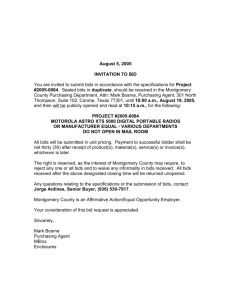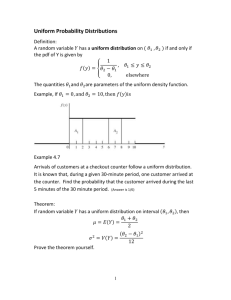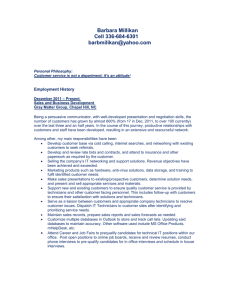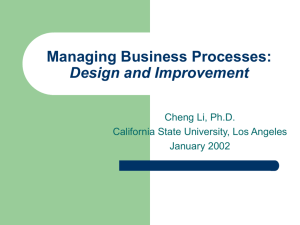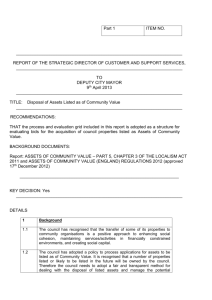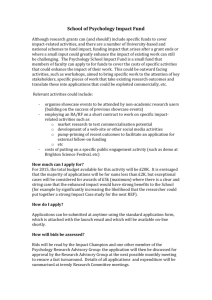Work Process Design and Improvement
advertisement
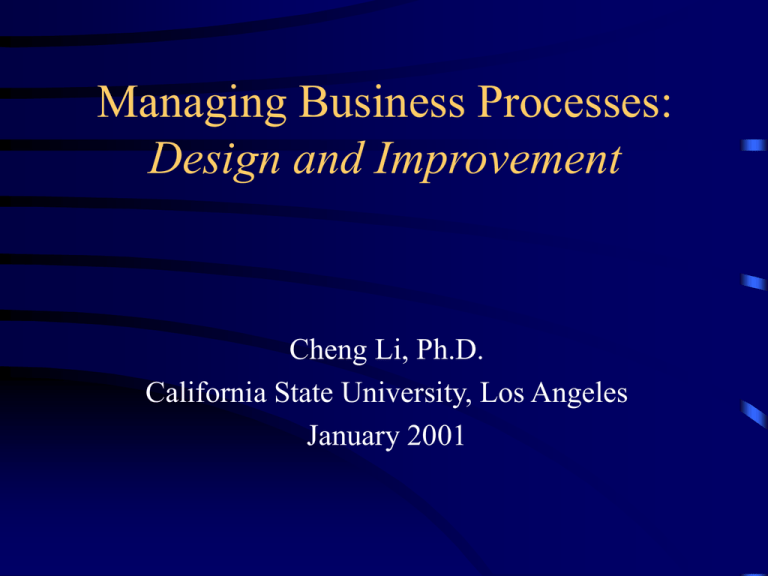
Managing Business Processes: Design and Improvement Cheng Li, Ph.D. California State University, Los Angeles January 2001 The Process Focus • The changing emphasis of management practices: from individual activities to process • Background: – Local optimization is inadequate. – Activities are increasingly integrated. What is the business process approach? • A work process: a set of related activities that adds value and provides a service to a customer. • The process focus: – integrative – cross-functional – customer orientation What is covered? • • • • • Business Process Improvement Business Process Modeling Process Structure Total Quality Management Business Process Reengineering Business Process Improvement What is business process improvement? • Process Improvement: how to do our work better in terms of customer satisfaction, cost reduction, and self-fulfillment, etc. • Related Process Management Theories: – Reengineering (Michael Hammer) – Continuous improvement or TQM – BPI: Business Process Improvement (James Harrington) The Four Phases of Process Improvement • • • • Description Analysis Design Implementation Process Description • Customers • Activities – Primary (value-adding) activities – Supporting (non-value-adding) activities • Work flow • Policies and constraints • Output: process flowcharts & description Process Analysis • Identify potential improvement areas – sources of information: internal and external – problems and causes • Identify related work processes and prioritize improvement projects • Output: major problems, causes of the problems, targeted work processes Process Design • Customer requirements – e.g. telephone repair: short down time, when it can be repaired, convenient hours, short waiting time • Design parameters – e.g. telephone repair: training of the operators, computer systems, # technicians • Relationships between requirements and parameters QFD: Quality Function Deployment • Example: a relationship matrix Down Time When Convenience Training Computer System WEAK WEAK STRONG #Technicians STRONG STRONG Process Design (cont.) • • • • • Generating ideas Evaluating alternatives Designing the new process Setting policies and controls Other issues: feedback mechanism, justification of the new process Implementation • • • • • • Planning Work process changes Policy changes Organizational changes Training Promotion and education Business Process Modeling Business Process Modeling • Description of the Process – Flowchart: procedures, policies and constraints – Data on process flow • Queuing Theory • Simulation Basic Techniques: Process Flowchart • e.g. student registration process – – – – get a copy of class schedule select classes, consult advisor if necessary make payment wait for authorization: pin number, time window – call the system – register, etc. Process Flowchart: symbols • Examples: Action/Operation Decision (If …) Delay Transportation Process Modeling Languages • Process Modeling Languages • QPL: Quality Process Language by Gary Born Process Modeling Languages • Process, input, output, the process owner, and authorities list of bids Evaluate Bids ---------------- list of bids Purchasing Officer Selected supplier Quality Process Language • Unchanged and Changed Output: – list of bids: unchanged – selected supplier: changed list of bids Evaluate Bids ---------------- list of bids Purchasing Officer Selected supplier Quality Process Language • Process Owner: a person or a machine responsible for execution of processes list of bids Evaluate Bids ---------------- list of bids Purchasing Officer Selected supplier Quality Process Language • Process Owner: variable list of bids Evaluate Bids ---------------- list of bids Purchasing Officer Choice of purchasing officer Selected supplier Quality Process Language • Authorities: provide rules and guidance on how to process information Purchasing procedures list of bids Evaluate Bids ---------------- list of bids Purchasing Officer Selected supplier Modeling Information • Information is the link between processes. • Classifying information based on versions to keep. • Channel: temporary • Information Store: only the current version • Archive: current and previous versions Modeling Information • Symbols: I channel Information Store Archive Queuing Theory • System Characteristics – Population source: finite, infinite – No. of servers – Arrival and service patterns: e.g. exponential distribution for inter-arrival time – Queue discipline: e.g. first-come-first-serve Queuing Theory • Performance Measurement: e.g. infinite source, single server, exponential interarrival and service times, first-come-firstserve: – System utilization – Average no. of customers: in line and in system – Average waiting time: in line and in system Queuing Theory • Procedure: – describe the process – collect data on incoming and service patterns – find formulas and/or tables, software to calculate performance measures Process Structure Strategic Positioning through Process Structure • Complexity: – e.g. preparation process: fast food vs. gourmet food • Divergence: degree of customization, the amount of discretion or freedom allowed – e.g. H&R Block vs. CPA firms – e.g. Options for Mercedes vs. for Camry Competitive Advantages through Process Structure • Competitive Advantages • Competitive Strategies • e.g. Sam’s Club vs. Nordstrom – layout, selection, service process, personnel • Competitive Strategy and Structural Positioning Example: Structural Alternatives for a Family Restaurant Lower • no reservations • self-seating, menu on board • customer fills out form • pre-prepared, no substitute, limited to 4 choices Current take reservation seat guests, give menus Serve water and bread Take orders Prepare orders: salad (4), entrée (15) Higher specific table selection recite menu, describe entrees and specials assortment of hot breads at table, taken personally individually prepared Generic Approaches to Service System Design • Production Line Approach – – – – limited Discretionary Action of Personnel division of labor substitution of technology for people service standardization Generic Approaches to Service System Design • Customer as Coproducer – substitution of customer labor for provider labor – smoothing service demand Generic Approaches to Service System Design • Customer Contact Approach – Degree of customer contact – Separation of high- and low-contact operations Total Quality Management TQM/Continuous Improvement • The Concept of Total Quality • The Dynamics of Quality Improvement: continuous improvement vs. tradeoff balancing • Employee Involvement • Emphasis on Customer Satisfaction Statistical Process Control • Emphasis on the process instead of the product/material • Focus on “prevention” Statistical Process Control • Control Charts: – – – – Mean Chart Range Chart p-Chart c-Chart • Process Capability • Process Capability Index Other TQM Tools • • • • • • Check sheet Scatter diagram Histogram (frequency) Pareto chart Control chart Cause-and-effect diagram Business Process Reengineering Business Process Reengineering • Evolution vs. Revolution • Bottom-up vs. Top-down • Break the routine: – habits – assumptions – values Reengineering: Assumption Busting • Problem: a specific performance shortcoming of the process • Rule: A specific aspect of the process design that causes the problem • Assumption: a belief about the environment that gives rise to the rule Reengineering: Assumption Busting Example: • Problem: Customers don’t know when the repair can be done. • Rule: The operator does not have the authority to schedule technicians. • Assumption: The operator does not know where the problem is and does not have information about technicians’ schedules. Overcoming Resistance to Change • • • • Resistance is natural and inevitable: expect it Resistance doesn’t always show its face: find it Resistance has many motivations: understand it Deal with people’s concerns rather than their arguments: confront it • There’s no one way to deal with resistance: manage it The Key Mechanisms for Overcoming Resistance • • • • Incentives: positive and negative Information: dispel uncertainty and fear Intervention: one-on-one connections Indoctrination: make change seem inevitable • Involvement: make people part of the effort The Ten Principles of Communications • • • • • Segment the audience Use multiple channels Use multiple voices Be clear Communicate, communicate, communicate The Ten Principles of Communications (cont.) • • • • • Honesty is the only policy Use emotions, not just logic Heal, console, encourage Make the message tangible Listen, listen, listen The People Side of Processes • People are the most important asset • Empowerment – a sense of achievement in what is accomplished – a sense of control over the means of production – a pace of work which is appropriate for both the worker and what is produced The People Side of Processes • Csikeszentmihalyi (1990): elements of enjoyable work: – – – – – capable of completing the task and allowed full control able to concentrate entirely on the work in hand clear goals immediate feedback deep involvement: free from everyday worries, unaware of time – “Our sense of self disappears, only to return with added strength when the task is finished.” The People Side of Processes • Consultation: part of empowerment • Teamwork: – size: small enough so that individual effort can make a difference – organization – conflict resolution – responsibility and authority – team dynamics – cultural background

